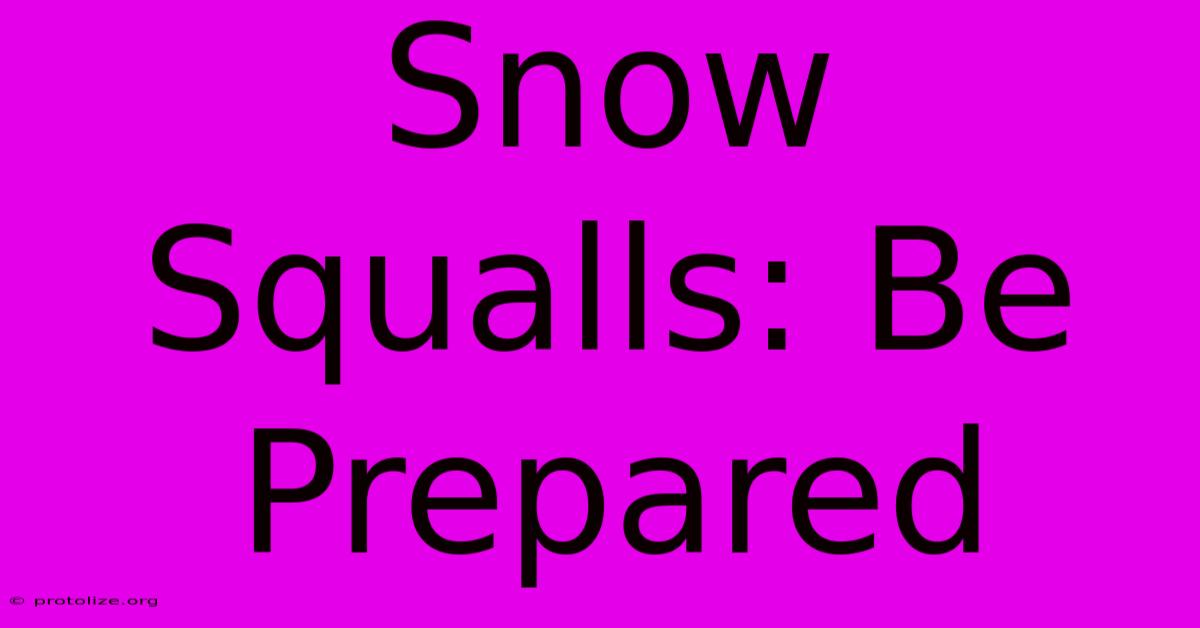Snow Squalls: Be Prepared

Discover more detailed and exciting information on our website. Click the link below to start your adventure: Visit Best Website mr.cleine.com. Don't miss out!
Table of Contents
Snow Squalls: Be Prepared for Sudden, Intense Winter Storms
Snow squalls are fierce winter weather events that can bring dangerously sudden and intense snowfall, significantly impacting visibility and travel conditions. Understanding what they are and how to prepare for them is crucial for staying safe. This article will cover everything you need to know about snow squalls and how to be prepared.
What is a Snow Squall?
A snow squall is characterized by intense bursts of heavy snowfall, often accompanied by strong winds and significantly reduced visibility. Unlike a typical snowstorm, which develops gradually, snow squalls can appear unexpectedly and disappear just as quickly. These short-lived but powerful storms can dump several inches of snow in a matter of minutes, creating hazardous driving conditions and potentially causing power outages.
Key Characteristics of Snow Squalls:
- Sudden onset: They develop rapidly with little to no warning.
- Heavy snowfall: Intense snowfall rates can accumulate quickly.
- Strong winds: Gusty winds reduce visibility further.
- Significant reduction in visibility: Visibility can drop to near zero in a matter of seconds, making driving extremely dangerous.
- Short duration: While intense, snow squalls are typically of short duration, lasting from minutes to a few hours.
How to Prepare for a Snow Squall
Preparation is key to staying safe during a snow squall. Here’s a checklist of things you should do:
Before the Storm:
- Monitor weather forecasts: Pay close attention to weather alerts and warnings issued by your local meteorological service. Many weather apps provide real-time updates and severe weather alerts. Knowing a snow squall watch or warning is in effect allows you to prepare and stay informed.
- Prepare an emergency kit: Keep a well-stocked emergency kit in your vehicle and at home. This kit should include blankets, extra warm clothing, food and water, a flashlight, a first-aid kit, and any necessary medications. A fully charged portable power bank is also essential for staying connected.
- Charge electronic devices: Ensure your phone and other electronic devices are fully charged.
- Check your vehicle: Make sure your vehicle is in good working order. This includes checking tire pressure, tire tread, battery, and antifreeze levels. Keeping a full tank of gas is also a good precaution.
During a Snow Squall:
- Stay indoors: If a snow squall is imminent or already occurring, the safest place to be is indoors. Avoid unnecessary travel.
- If driving is unavoidable: Reduce your speed significantly and increase following distance. Turn on your headlights and use your hazard lights. Avoid sudden braking or acceleration. If visibility becomes too poor, pull over safely to the side of the road and wait for the squall to pass.
- Be aware of changing conditions: Snow squalls can create whiteout conditions which dramatically reduce visibility.
- Be patient: Allow extra time for travel, even if the squall seems to have passed. Road conditions can remain treacherous after the snow stops falling.
After the Snow Squall:
- Check on your neighbors: Check on elderly or vulnerable neighbors to ensure their safety.
- Clear your property: Remove snow and ice from walkways and driveways to prevent slips and falls.
- Report downed power lines: If you encounter any downed power lines, report them immediately to your local utility company.
Snow Squall Safety Tips for Drivers
Driving during a snow squall is extremely dangerous. If you must travel, remember these essential safety tips:
- Slow down: Reduce your speed to a crawl, allowing ample time to react to changing conditions.
- Increase following distance: Maintain a significant following distance from the vehicle in front of you.
- Turn on your headlights: Ensure your headlights are on to improve visibility.
- Use your hazard lights: Consider using your hazard lights if visibility is significantly reduced.
- Avoid sudden maneuvers: Avoid sudden braking, acceleration, or lane changes.
By following these tips and being prepared, you can significantly reduce your risk during a snow squall. Remember, safety should always be your top priority during severe winter weather. Stay informed, stay prepared, and stay safe!

Thank you for visiting our website wich cover about Snow Squalls: Be Prepared. We hope the information provided has been useful to you. Feel free to contact us if you have any questions or need further assistance. See you next time and dont miss to bookmark.
Featured Posts
-
Arsenal 3 0 Monaco Match Highlights
Dec 13, 2024
-
Court Victory For Deeming Against Pesutto
Dec 13, 2024
-
Best Erp System Uk
Dec 13, 2024
-
Sub Zero Temperatures Hit North Dakota
Dec 13, 2024
-
Public Availability Microsoft 365 Copilot Gcc
Dec 13, 2024
